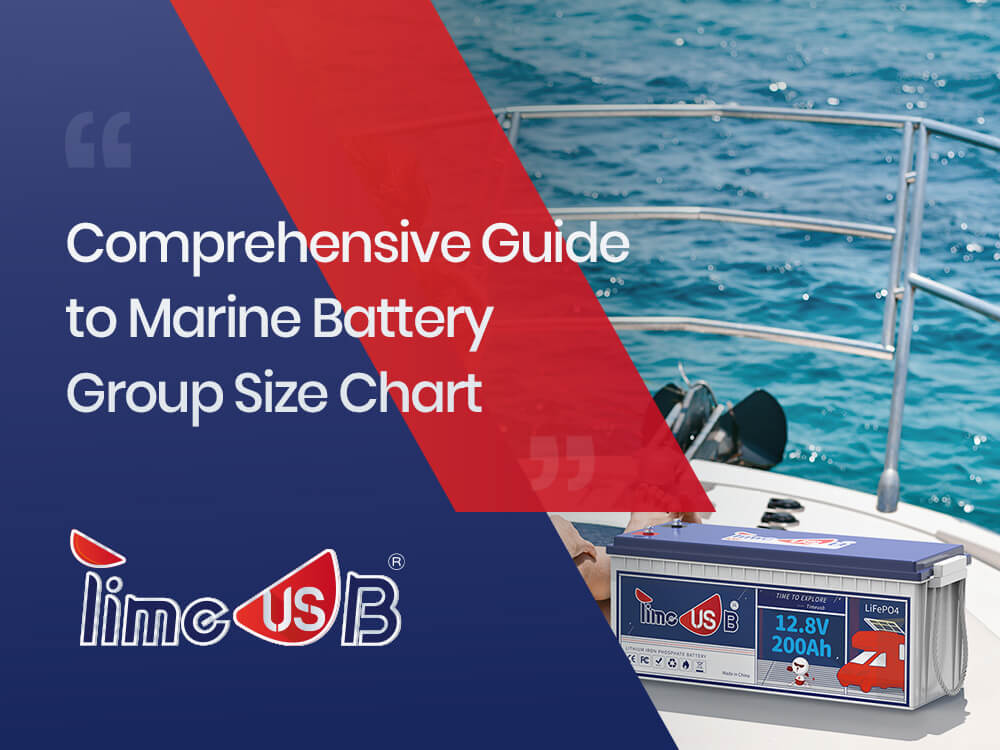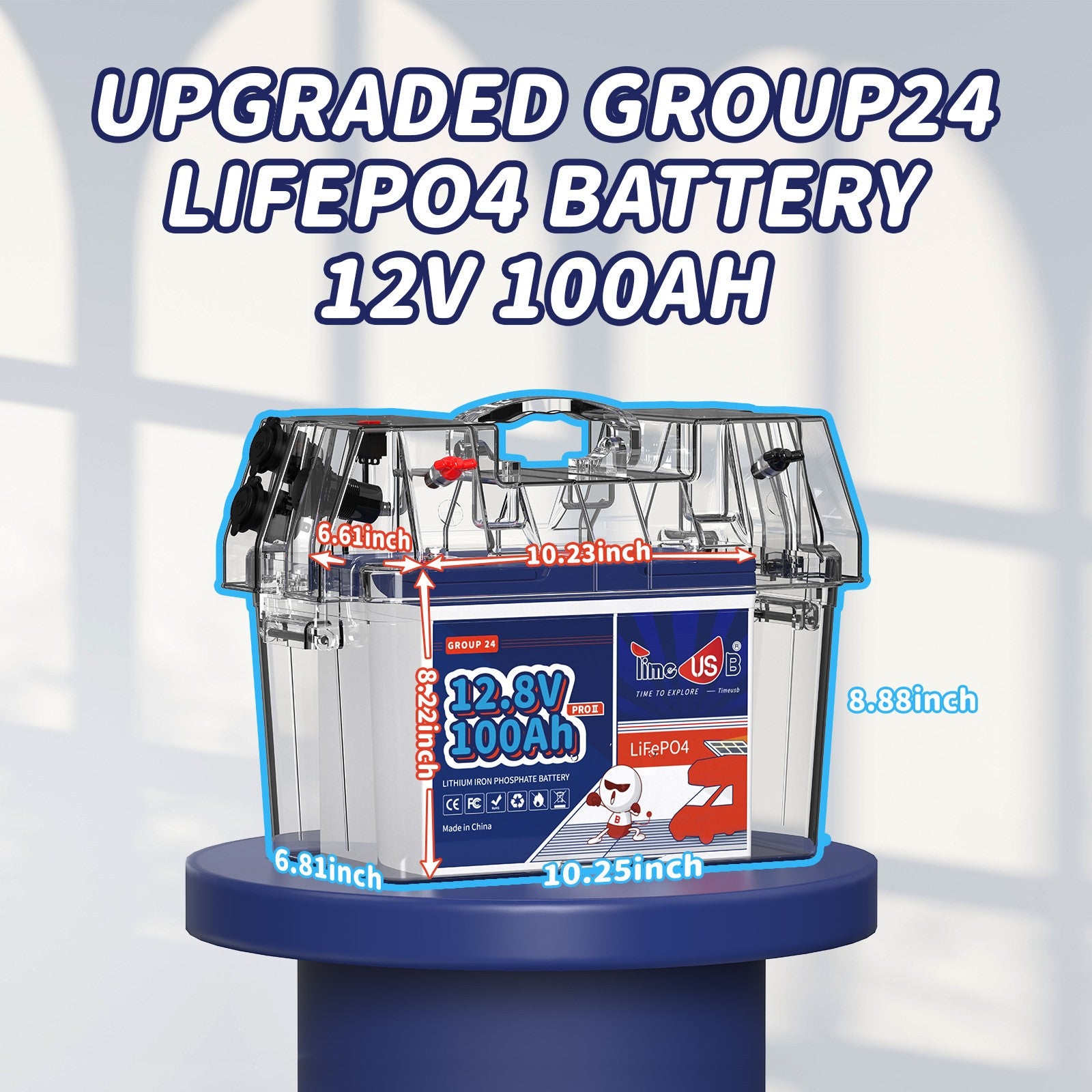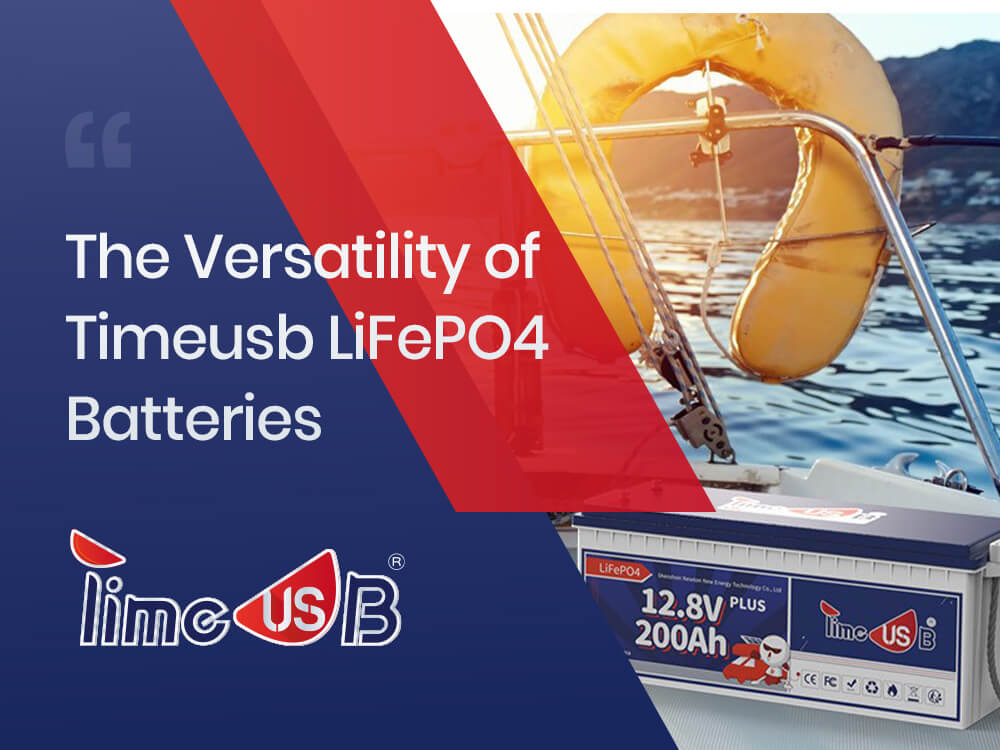Comprehensive Guide to Marine Battery Group Size Chart

Hello, everyone! This week's blog is dedicated to exploring the Marine Battery Group Size Chart.
Power is crucial for boats, and marine batteries play a vital role in optimizing your vessel's performance on the water. These batteries fuel your electronics, navigation systems, and engine ignition. Selecting the appropriate marine battery is essential for ensuring seamless and efficient boat operation.
Join us as we present Timeusb's comprehensive guide to marine battery pack size charts, detailing which lithium batteries are compatible. We believe this blog will be invaluable to you.
What Is A Marine Battery
There are two types of marine batteries, starter and deep cycle.
Marine starter batteries, alternatively labeled as marine cranking batteries or marine engine start batteries, belong to the category of lead-acid batteries meticulously crafted to initiate boat engines. These batteries are intricately designed to deliver ample cranking amps (CA) and cold-cranking amps (CCA), guaranteeing swift ignition of boat engines.
Conversely, a deep cycle marine battery is engineered to provide sustained power over prolonged periods, making it ideal for scenarios demanding reliable and consistent energy, particularly in marine environments. Engineered to withstand multiple charging and discharging cycles, these batteries maintain peak performance, ensuring dependable operation for a wide range of marine electronics, navigation systems, and onboard utilities. This article mainly discusses deep cycle marine battery.
For those interested, here's a link to purchase deep cycle marine batteries.
Key Takeaways
- Selecting the appropriate marine battery group size is crucial for ensuring the battery fits properly and meets your power requirements.
- Understanding these sizes helps you choose a battery that offers optimal performance, capacity, and cranking amps for your marine needs.
- The marine battery size chart gives an overview of BCI group sizes, aiding in making informed decisions. Typically, larger group sizes indicate greater battery capacity, regardless of the battery type.
- Regular maintenance and inspection are essential for maintaining reliable power and extending the battery's lifespan.
What Does Group Size Mean?
Group size serves as a standardized categorization system, indicating a battery's physical dimensions and terminal placement, thereby dictating its compatibility with specific vehicles or machinery. Upheld by organizations like the Battery Council International (BCI) for automotive and marine batteries, this uniform code ensures consistency and interchangeability among batteries produced by different manufacturers. A comprehensive understanding of battery group sizes is essential for selecting the ideal battery to power various devices.
The Difference Between A Regular Battery and A Marine Battery
Marine batteries are crafted with thicker internal lead plates compared to car batteries, enabling them to discharge energy gradually over extended durations. This feature is unique to deep cycle batteries, differing from starting batteries. Additionally, their housings are generally larger than those of equivalent car batteries, integrating additional plastic shielding. This added protection is crucial due to the rougher conditions encountered in boating environments, which significantly differ from the smoother surfaces of on-road driving.
The Group Size Chart

Group 24 Battery Vs Group 27 Battery
1. What is a Group 24 battery and a Group 27 battery?
The Group 24 battery is a commonly encountered standard model, measuring 10.5 inches in length, 6.1875 inches in width, and 8.875 inches in height. This specific battery size finds widespread use in various vehicles, backup power systems, and medical equipment. Typically, Group 24 batteries are employed as deep cycle batteries rather than for engine starting purposes.

On the other hand, the Group 27 battery is also a standard model, measuring 12.5 inches in length, 6.75 inches in width, and 9.37 inches in height. This battery size sees extensive usage in automotive, marine, off-the-grid, RVs, and similar applications, including backup power systems. In comparison to the Group 24 battery, the Group 27 battery is larger in size.
2. Comparison between group 24 battery Vs group 27 battery
(1) Battery Chemistry
Regardless of whether it's Group 24 batteries or Group 27 batteries, the most prevalent BCI Group battery chemistries include Flooded Lead Acid (FLA) and Sealed Lead Acid (SLA).
- AGM (Absorbent Glass Mat) Batteries
- Sealed Lead Acid (SLA) Batteries
- Gel-cell Batteries
- Flooded Batteries
- Lithium-ion Batteries
While lead-acid batteries stand out as the most economical option among them, lithium batteries offer a longer cycle life and have attracted significant interest due to their eco-friendly nature and recyclability. If you're considering purchasing lithium batteries in group sizes, you can explore our selection of Timeusb lithium batteries.

(2) Size
Group 24 batteries adhere to standard group dimensions of 10.25 x 6.8125 x 8.875 inches or 260 x 173 x 225 mm, while Group 27 batteries measure 12.0625 x 6.8125 x 8.875 inches or 306 x 173 x 225 mm.
Interestingly, they share identical width (6.8125 inches or 173 mm) and height (8.875 inches or 225 mm) but differ in length.
This indicates that battery compartments designed for Group 24 batteries typically cannot accommodate Group 27 batteries. However, compartments intended for Group 27 batteries may accommodate Group 24 batteries.
(3) Capacity
In contrast to Group 24 batteries, Group 27 batteries typically offer slightly higher capacities. Generally, battery group sizes with higher numerical values tend to provide more amp hours than those with lower values.
(4) Applications
Group 24 batteries find common usage in various applications such as:
- Backup storage systems
- Large UPS systems
- Wheelchairs
- Medical and security systems
- Industrial applications
A deep cycle Group 24 battery, like the Timeusb Group 24 lithium battery, is downsized for seamless compatibility with BCI Group 24 Size. This battery, 25% smaller than the Timeusb 12V 100Ah LiFePO4 Battery Group 31, is suitable for various motorhome battery casings such as Group 24/27/31 battery boxes. Despite the size reduction, the energy remains unchanged at 1.28 kWh, increasing the energy density by over 40%. Compact yet powerful, it fulfills your energy needs, enhancing your lifestyle on the go.

Conversely, Group 27 batteries find applications in off-grid setups, RVs, automotive, marine, and similar scenarios.
Are Group 27 and 31 Batteries the Same Size?
A Group 31 marine battery surpasses the dimensions of a Group 27, measuring 12.8 inches in length, 6.8 inches in width, and 9.3 inches in height. This slight enlargement accommodates greater power storage capacity, rendering it an optimal selection for boats equipped with advanced electronic systems and as house batteries in RVs and solar power installations.
AGM Group 24 Battery vs Lithium Group 24 Battery
1. Drawbacks of AGM Group 24 Battery:
- Susceptible to Overcharging: AGM batteries are prone to overcharging, which can lead to reduced lifespan and potential damage if not properly regulated by an appropriate charging system.
- Limited Deep Discharge Capability: While AGM batteries are designed to handle deep discharges better than conventional flooded batteries, they still have limitations in terms of discharge depth compared to alternative types of deep cycle batteries like lithium-ion.
- Temperature Sensitivity: AGM batteries can be sensitive to temperature extremes. High temperatures may accelerate aging and reduce lifespan, while very low temperatures can impair performance and capacity.
- Heavier Weight: AGM batteries typically weigh more than flooded lead-acid batteries of comparable capacity, which can be a concern for applications where weight is critical, such as in marine or RV use.
- Maintenance Requirements: While AGM batteries require less maintenance compared to flooded lead-acid batteries, they still need periodic upkeep to ensure optimal performance and longevity, including regular charging and occasional equalization.
- Limited Availability: Depending on your location, AGM Group 24 batteries may not be as readily available as other battery types, potentially complicating replacement or spare sourcing efforts.
2. Advantages of Group 24 Lithium Battery:
- High Energy Density: Lithium batteries boast significantly higher energy density compared to traditional lead-acid batteries, enabling them to deliver more power in a smaller and lighter package. For example, the energy density of a lithium battery is 61Wh/lbs, whereas that of an AGM battery is 52Wh/lbs.
- Longer Lifespan: Lithium batteries outlast lead-acid batteries, with many lithium variants rated for thousands of charge cycles, ensuring consistent power supply over an extended duration. For instance, the Timeusb Group 24 battery boasts a lifespan of 4000-15000 cycles, equating to over 10 years of usage, whereas AGM batteries typically offer only 500-1200 cycles.
- Fast Charging: Lithium batteries can be charged considerably faster than lead-acid batteries, resulting in shorter charging times and quicker turnaround between uses. Under similar conditions of deep discharge, lithium batteries require only 5 hours for charging, whereas AGM batteries take more than 8 hours.
- Deep Discharge Capability: Lithium batteries can be discharged to much lower levels without sustaining damage, providing increased usable capacity and flexibility in power consumption.
- Maintenance-Free: Lithium batteries require minimal maintenance compared to lead-acid batteries, eliminating the need for regular watering, cleaning, or equalization.
- Lightweight: Lithium batteries are notably lighter than lead-acid batteries of similar capacity, making them ideal for weight-sensitive applications such as marine or RV use. Timeusb 12V 100Ah Group 24 batteries weigh a mere 21lbs, which is approximately 2/3 lighter than a 12V 100Ah AGM battery (65lbs).
- Temperature Tolerance: Lithium batteries exhibit excellent performance across a broad temperature range, making them suitable for deployment in extreme environments without significant performance degradation.
- Efficiency: Lithium batteries demonstrate high charge and discharge efficiency, resulting in minimal energy loss as heat during charging and discharging processes, thereby maximizing the utilization of stored energy.
- Low Self-Discharge: Lithium batteries possess a remarkably low self-discharge rate, enabling them to retain their charge for longer periods during periods of inactivity compared to lead-acid batteries.
- Compatibility with Renewable Energy Sources: Lithium batteries are well-suited for integration with renewable energy sources like solar or wind power due to their efficient and effective energy storage capabilities.
| Feature | AGM Battery | Lithium Battery |
|---|---|---|
| Energy Density (Wh/lbs) | 52 | 61 |
| Lifespan (Cycles) | 500-1200 | 4000-15000 |
| Charging Time (under deep discharge) | More than 8 hours | 5 hours |
| Deep Discharge Capability | Limited, more prone to damage | High, less prone to damage |
| Maintenance-Free | Requires regular watering, cleaning, equalization | Requires minimal maintenance |
| Weigh of 12V 100Ah group 24 batteries (lbs) | 65 | 21 |
| Temperature Tolerance | Significant performance loss in extreme environments | Performs well across a wide temperature range |
| Efficiency | Lower charge and discharge efficiency, significant energy loss | High charge and discharge efficiency, minimal energy loss |
| Low Self-Discharge | Relatively higher self-discharge rate, faster discharge when stored for extended periods | Very low self-discharge rate, holds charge for longer periods |
| Compatibility with Renewable Energy Sources | A reliable choice for pairing with solar panel systems In some cases | Suitable for use with renewable energy sources such as solar or wind power |

These advantages establish Group 24 lithium batteries as a favored option across a spectrum of applications, including marine vessels, recreational vehicles (RVs), off-grid solar setups, and electric vehicles (EVs).

In conclusion, lithium batteries have emerged as the preferred choice for consumers seeking a more environmentally conscious battery option. Timeusb's lithium battery products are currently featured in a hot promotion. Interested individuals should seize this opportunity without delay!
FAQs about Marine Battery Group
1. What are the group sizes for marine batteries?
While the BCI group size spectrum encompasses various sectors such as passenger cars, electric vehicles, and commercial batteries, our focus today centers on sizes primarily utilized in marine applications. These include batteries classified under Group 24, Group 27, Group 31, and 8D.
2. How does Group 31 differ from Group 34 marine batteries?
The Group 34 marine battery slightly exceeds the dimensions of the Group 31. It measures 13.5 inches in length, 6.8 inches in width, and 9.3 inches in height.
3. What types of marine batteries are available?
There are four chemical types of marine batteries tailored for diverse applications: flooded, gel, Absorbed Glass Mat (AGM), and lithium.
Conclusion
The marine battery market provides various options, featuring three standard sizes: 24, 27, and 31. We recommend assessing the cabin size before deciding on a battery size for purchase. Selecting the most appropriate size is crucial. Additionally, you have the option to upgrade from an AGM group 24 battery to a lithium group 24 battery for enhanced benefits!


![[Full Guide] The Comprehensive Guide to LiFePO4 Battery Life](http://www.timeusbpower.com/cdn/shop/articles/The_Comprehensive_Guide_to_LiFePO4_Battery_Life_757d2749-9468-4739-ac83-0960c27749b0.jpg?v=1722918256&width=1080)
